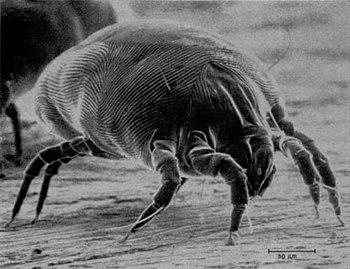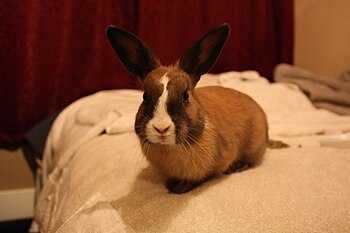If you live with pets, it is likely that your allergies are at least in part triggered by the protein in your pet's dander. The symptoms result when your immune system determines that it is harmful and tries to eliminate it.
Since all warm-blooded animals shed dander, it doesn't matter if you love a dog, cat, bird, or ferret, they all have the potential to trigger symptoms. So if you know you have allergies fish make nice pets without the dander. But if you've already fallen in love with something other than fish, here are 5 ways to minimize the symptoms your pet causes.
Keep Cleaning---Pets give a lot of love, and in return those of us who love them unconditionally know that there will be more clean up involved.
 |
| The house dust mite, its feces and chitin are common allergens around the home (Photo credit: Wikipedia) |
You will know how often you need to clean based on how much dust your friend creates. Remember to avoid dry cleaning (dusting, sweeping) and opt for cleaning with water.
Remember to wash pet bedding as dust mites will eat pet dander too. Wash any area rugs weekly. Use window coverings that can we washed or wiped down to keep particulates from accumulating.
Limit piles because they create extra surface area where dust can and will settle. Keep knick-knacks to a minimum for the same reason. Reducing these 2 things alone will cut down greatly on what you have to clean each week.
Keep The Numbers Low---Don't let a big heart get you in over your head.. So the temptation is to save every pooch with big eyes. Ultimately that is not the best thing for either of you.
Having large numbers of warm-blooded animals will increase the dander factor exponentially. This will eventually make it hard for you to breathe, often forcing the owner to place pets in a new home or a shelter. And that's hard on everyone. You can't explain your decision to your pet. Less is actually better.
Consider Baths---Always check with the veterinarian before implementing a bath regimen. However, this can often drastically reduce the amount of hair, dander, dust, and/or feathers that is available for your pet to send into the air.
Use Allergy-Friendly Furnishings---What's this you are probably wondering? It's using furniture and accessories that allow particles to fall to the floor. Smooth surfaces rather than woven are best.
Leather or leather-like surfaces on chairs and sofas are an excellent choice because they will not allow particles to accumulate and can be easily and thoroughly wiped down to take particles out of circulation for good.
Flooring choices include area rugs, linoleum, tile, slate and other non-porous surfaces. Avoid wall-to-wall carpet because it is hard to clean thoroughly, and in between cleanings it allows a tremendous number of particulates and odors to accumulate.
The slightest amount of movement on the carpet will cause the particles to go airborne and available for you to inhale. This produces a catch-22 situation that can cause allergy symptoms to be annoying and on-going.
Filter The Air----Regardless of how careful you are, and how many steps you take to minimize the allergens generated by pets and other normal indoor activities, you will still have more than you want in your air.
The most reliable way to eliminate them consistently and effectively is to use multiple-sized filters to eliminate them from the air. Pre-filters are effective yet inexpensive ways to remove visible particulates.
The high efficiency particle arresting or HEPA filter is an excellent fit for microscopic particles like dander, mold and mildew spores, and dust mites. Designed to eliminate 99,997 out of every 10,000 particles that are .3 microns or larger, it is the best filter for the job.
Not only is this type of filtration effective it is also safe producing only fresh air as a by-product. Avoid those units that produce any amount of ozone or ionized particles. Experts can't seem to agree about if and how much is safe for living things.
Let the Pet Dander Air Purifier from PurerAir.com send 250 cubic feet of fresh, clean air into your home every 60 seconds. See it now at http://purerair.com/pet_dander_air_purifier.html
Article Source: EzineArticles
|






